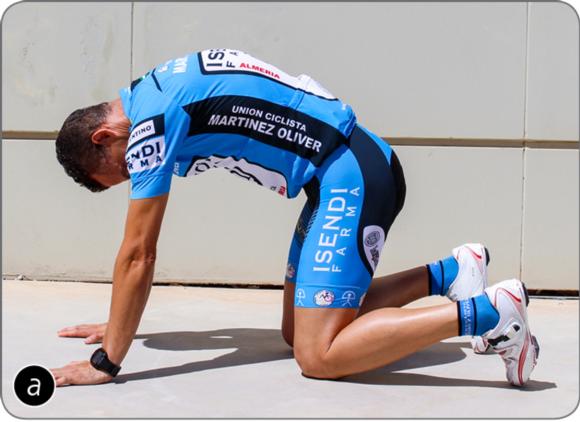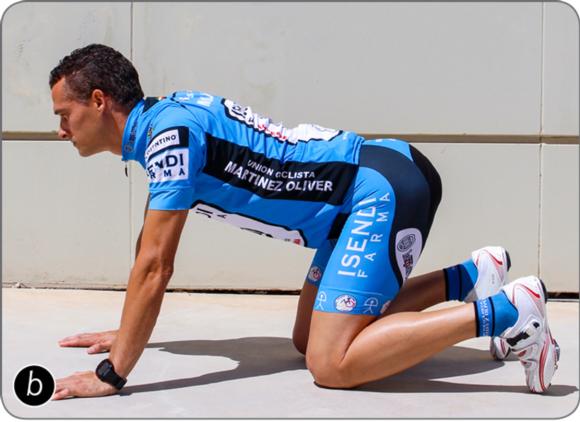Stretching to improve performance and prevent injury
This is an excerpt from Cycling Science by Stephen S Cheung,Mikel Zabala.
Although most athletes and coaches accept stretching as a means to improve performance and prevent sports injuries, studies regarding this issue offer conflicting conclusions (Andersen 2005; Ingraham 2003; McHugh and Cosgrave 2010). Ingraham (2003) reported that stretching performed to develop flexibility beyond the needs of specific sport movements can cause muscle injury and thus diminish athletic performance. After a systematic review of the literature on stretching, Andersen (2005) determined that the scientific evidence was insufficient to support the idea that stretching before exercise would reduce the risk of injury or lead to a decline in postexercise muscle soreness. McHugh and Cosgrave (2010) stated that stretching had an immediate and acute detrimental effect on performance and maximum force production. But these effects were less obvious in muscle strength tests and appeared to be absent when stretching was combined with low-intensity exercise in a warm-up protocol.
Focusing specifically on cycling, Wolfe et al. (2011) demonstrated that static stretching produced an acute effect during the first 25 minutes, increasing submaximal ![]() O2 and thus decreasing pedaling efficiency. Similarly, Esposito, Cè, and Limonta (2012) found that static stretching produced an acute immediate effect with a 4 percent decrease in mechanical efficiency and a 26 percent decrease in the duration of the constant-intensity cycling test at 85 percent of
O2 and thus decreasing pedaling efficiency. Similarly, Esposito, Cè, and Limonta (2012) found that static stretching produced an acute immediate effect with a 4 percent decrease in mechanical efficiency and a 26 percent decrease in the duration of the constant-intensity cycling test at 85 percent of ![]() O2max. Behm et al. (2004) found that the use of static stretching to warm up produced an acute effect that adversely affected balance and reaction time. Other studies, such as the work by O'Connor, Crowe, and Spinks (2006), observed that the inclusion of static stretching exercises in the warm-up protocol increased anaerobic power compared with a warm-up protocol that did not include these stretching exercises.
O2max. Behm et al. (2004) found that the use of static stretching to warm up produced an acute effect that adversely affected balance and reaction time. Other studies, such as the work by O'Connor, Crowe, and Spinks (2006), observed that the inclusion of static stretching exercises in the warm-up protocol increased anaerobic power compared with a warm-up protocol that did not include these stretching exercises.
Recently, Kingsley et al. (2013) examined the effects of static stretching and motor imagery on anaerobic performance in trained cyclists. Motor imagery was defined as the visualization of simple or complex motor activities in the absence of physical movement. These authors found that neither static stretching nor motor imagery negatively affected anaerobic performance in trained cyclists when the anaerobic test lasted less than 30 seconds.
Curry et al. (2009) compared the effects of three types of warm-up protocols (static stretching, dynamic stretching, and light aerobic exercise) on the range of motion and muscle strength in untrained women. These authors found no significant differences among the three protocols evaluated regarding range of motion or muscle strength, although they did find that dynamic stretching improves performance and muscle strength compared to static stretching.
As is apparent from the cited studies, the influence of stretching on athletic performance and the prevention of muscle injury is not yet clear. The methodological difficulty of designing a longitudinal study showing the long-term effects of stretching on these variables may be the reason that most of the studies published in the scientific literature have been designed to assess a particular effect in a specific context, generally the acute effect of stretching on muscle strength or on anaerobic performance.
Regarding cool-down, few studies have evaluated the effects of stretching as a recovery method after finishing a workout or cycling competition. Miladi et al. (2011) observed that dynamic stretching is an effective method for improving performance, cardiorespiratory measures, and lactate levels during intermittent supramaximal intensity tests in cycling. Other studies have reported that low-intensity aerobic exercise, such as cycling at 20 percent of ![]() O2max, is a method that facilitates performance recovery during intermittent high-intensity cycling exercise (Dorado, Sanchís-Moysi, and Calbet 2004) or after the completion of dynamic exercise to fatigue (Mika et al. 2007).
O2max, is a method that facilitates performance recovery during intermittent high-intensity cycling exercise (Dorado, Sanchís-Moysi, and Calbet 2004) or after the completion of dynamic exercise to fatigue (Mika et al. 2007).
In this regard, dynamic stretching is recommended as a part of warm-up, immediately before the main part of the training, or as a recovery method between high-intensity series. In contrast, passive stretching should be performed after the main activity as a cool-down or relaxation method after exercise (Peck et al. 2014).
In road cycling, low-intensity cycling for the first part of the ride could be used as a specific warm-up without the need to perform dynamic stretching exercises. Although not formally considered stretching, the cat - camel exercise (figure 34.1) is a motion exercise recommended for cyclists to use before mounting the bicycle to decrease the intraarticular viscosity of the spine (internal resistance and friction), improve spinal load distribution, and minimize spinal stress. The emphasis is on motion in the ranges of flexion and extension with the integration of the cervical, thoracic, and lumbar spine. The recommendation is to perform five to eight cycles to reduce most viscous-frictional stresses (McGill 2007).


Cyclist performing the cat - camel exercise: (a) cat; (b) camel.
José M. Muyor
In contrast, passive stretching exercises should be performed after training or competition to promote muscle recovery.
Learn more about Cycling Science.
More Excerpts From Cycling ScienceSHOP

Get the latest insights with regular newsletters, plus periodic product information and special insider offers.
JOIN NOW
Latest Posts
- Sample mental health lesson plan of a skills-based approach
- Sample assessment worksheet for the skill of accessing valid and reliable resources
- Help your students overcome what holds them back from making health-promoting choices
- Example of an off-season microcycle
- Modifying lifts
- Screening for multilevel programs in a team environment


